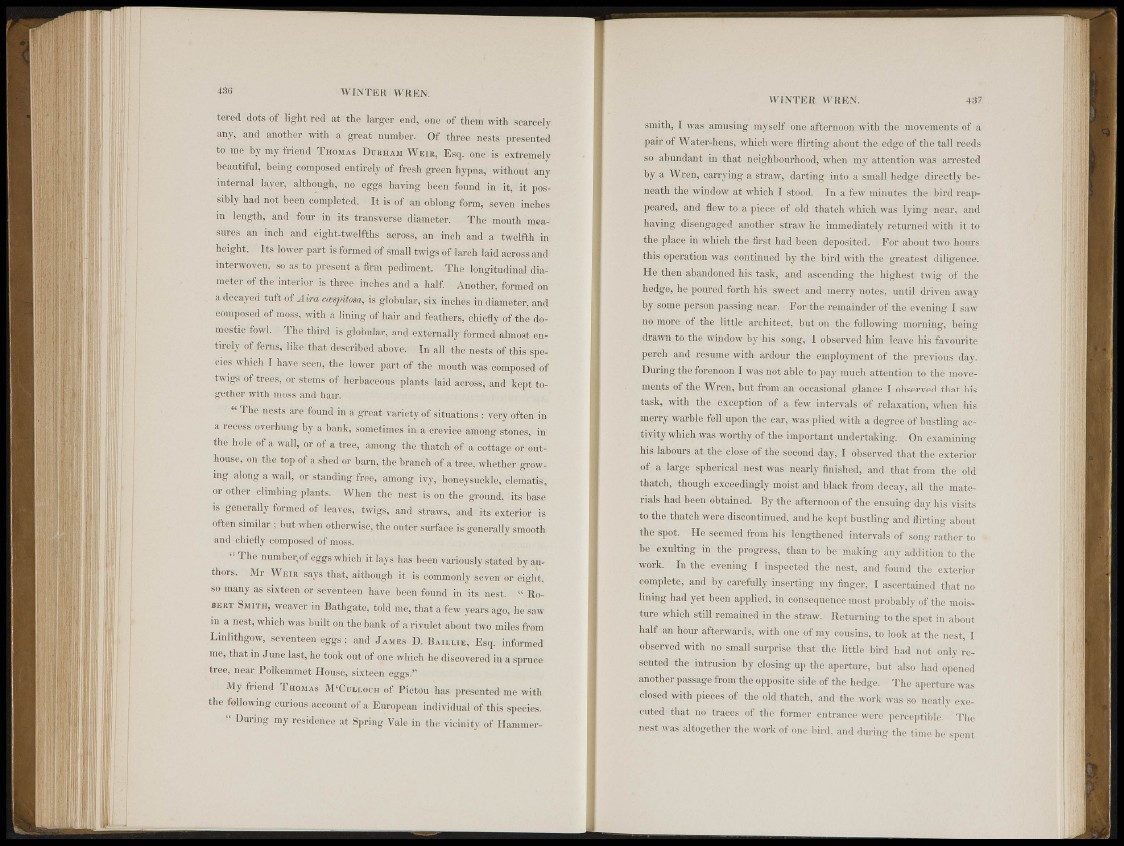
436 WINTER WREN.
t « e d (lots of ¿ight red at the ftkfes end, one'of then, with «<««%
lm.v> un<i another with ta> great number. ' Of throo-Muists .prooent.Kl
to me hy niv friend Thomas I)i:rha.m Wrir, Iisq. one is- extremely
beautiful, being composed entirelyrof fresh igree'nliypna, without any
iMerhal layer, although, «#4|gs having been found in i f^f t possibly
had not been completed. It is'of an oblong form, seven inches
in length, and four in «its transverse diameter; The mouth measures
an inch tod eighfctwiMhB • Wrqss, an iiiicli and a twelfth in
h..ight.8»Its lower part is formed of small twig* ,,f larch laid across an.I
interwoven, so as p present a firm pediment. The lii'tigiludma! diameter
of the interior is throe'-in,rites and a half. Another, formed»,,,
- a tuft mAwa'dwsp.tosa, is globular, six inches in diameter, and
composed of moss with a lining#f hair and feathers,. .¿Me% of the doi
f e t i e fowl. The third is<gMJuJar, and externaUytfsrtneduaJmost.en-
- tii-ely of ferns;, like that described above. In all the nosts of this sppi
cies^which I have,seen, the lower part of the mouth was composed of
twigs of trees, g stems of herbaceous plants laid' across, aid iept together
with rnoss'iind hair.
" The nests are found in a great variety of situations : very often in
a recess overhung by » bank, sometimes in. a crevice am'ong-stones,«to
the hole of a wall, or of a tree, among the thatch of a,cottage or out.
house, on ftei baa, the branch of ¿Tree-,, whether growing
along a wail, of standing free, among ivy,- honeysuckle, clematis,
oT other climbing plants When the nest*onthe ground, its'baS^
is generally formed of loaves, twigs, and straws, and its,exterior is
often Similar ; but when otherwise, the outer surface is generally smooth
and chiefly composed of moss. •
" The number,of eggs which it lays has been variously stated by authors,
Mr Wkik says that, although it is commonly Seven or eight,
so many as sixteen or seventeen have been- found in itSfnest. " R„-
BEK® fiMn'ii, weaver*! Bathgate, told mo, that a few years ago, he'saw
in a nqsit, which was huiltigi the bank of a rivulet about two -miles from
Linlithgow^ .teTettWfeggs, and James D BirntiE, Esq. mformed
rao'tilat in J l m e lait> He took out of one which be discovered in a spruce
tree,, Hear Poltemmet House, sixteen
My friend Thomas M'Guiioe«uMJPictOu 'has presented me with
.the following curious account of a Kim,pear, individual of this species.
S' KOTi n g m y reSilence. at Spring Vale in the Vicinity. of Hammer
WINTER WREN. 48?
smith, I n.'H amusing myself one afternoon with the movements of a
pair of Water-hens, which were flirting about the edge of the tail reeds
gS> abundant in that neighbourhood,- when my attention was arrested
by n Wron, carrying a. straw, darting into a small hedge directly beneath
the window at which I stood. In a few minutes the bird reappeared,
and flew to a piece of old thatch which was lying near, and
•laving disengaged another straw he immediately returned with it to
the placé, in which the first had been deposited. For about two hours
this .operation was continued by the bird with the greatest diligence.
Be then abandoned his task, and ascending the highest twig of the
hedge, he poured forili his swoot and merry notes, until driven away
person 'passing- near. For-the remainder of the; evening I saw
no more of tin- little architect, but on the following morning, being
drawn to thé window by his song, 1 observed him leave his favourite
port-K and resume with ardour the employment of the previous day.
During Ilio forenoon I was not able to pay much attention to thè movo
mpnt.s of the Wren, but from an Occasional glance I observed that his
task, with thé .exception of a few intervals of relaxation, when his
merry warble foil-upon the!,ear, was plied with a degree of bustling activity
which was worthy of the important undertaking. : On examining
his labours at the close of the second day, I observed that the exterior
f.f a large spherical nest was nearly finished, and that fro;» the old
thatch, though exceedingly moist and black from decay, all the nia.ror
i a l s h a d be® Obtained; By the afternoon of the ensuing day his visits
to the thatch were discontinued, and he kept bustling and flirting about
the Spot. He seemed from his lengthened intervals Of song rather to
lie exulting in the progress, than to be making any addition lo the
work. In the evening1 I inspected the nest, aiïd found the exterior
complete, and by carefully inserting my finger, I ascertained that no
lining had yet been applied, in consequence most probably of the moist
t o e Which still remained in the straw. Returning to the spot in about
half an hour afterwards, with one of my cousins, to look at the nest, I
observed with no small surprise that the.'little bird had not only resented
the intrusion by closing, up the aperture, but also had opened
another passage from the opposite side of the hedge. The aperture was
closed with pieces of the old thatch, and the work was so neatly exe-
,«L«.d that no traces of the former entrance were perceptible. The
nest was altogether the work of one bird, and dining the time he spent